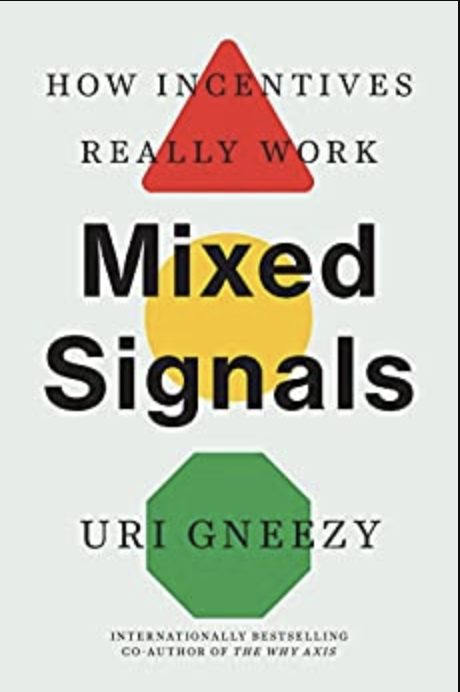Key Quote:
“Incentives send a signal and your objective is to make sure this signal is aligned with your goals.”
Key Points and Concepts
How Signaling Wins Markets
• Social signaling is “the concern we have over what others might think of us” (p. 9). People want
to be seen in a certain way, and social signals project “our core values and beliefs” (p. 9).
• Self-signaling is similar to social signaling but includes the concern that we as people have about ourselves and our behavior. “Every time we behave in accordance with our identity, we view ourselves positively” (p. 9).
• When applied together, social and self-signaling can create a change in values (p. 34). Combining both signals is used in marketing campaigns to create a need for self-expression and can change the way people feel about themselves and how others view them (pp. 34 & 39). Both signal type and size should be used to enhance signaling (p. 39).
• Signals are used to create and deliver credible messages (p. 21). Corporations can (and do) create signals to make a product stance, creating a reason for consumers to buy a product and find identity in it (p. 26). Creating signals can make a difference in engaging customers and standing out in a competitive market (p. 29).
Avoid Mixed Signals
• Incentives signal what is important to an organization, such as quantity or quality. What is incentivized for workers inside of an organization should align with the goals the organization is encouraging (p. 48).
• If an organization is encouraging innovation, it cannot punish failure. Punishing failure will deter future risk-taking, reduce the ability to learn from failure, and will cause employees to hide their failures in fear of broadcasting their mistakes (p. 62).
• Cultures that accept mistakes and encourage conversations about failures are likely to have higher failure rates but will increase their success rates (p. 62). “A high failure rate is associated with innovation, and aiming to reduce failure rates is not always a useful strategy… the most creative people have the greatest failure rates because
they try the most ideas” (p. 63).
• An incentive timeline should align with goals. Company executives who receive mixed signals would rather delay or sacrifice projects in favor of short-term gains instead of investing in a long-term solution that can help a company’s success (pp. 71-72). One idea to encourage leaders from taking short-term incentives is to give them more time in a position to prioritize long-term performance (p. 73).
How Incentives Shape the Story
• Bad incentives can be worse than no incentives at all (p. 105). In 1997, Wells Fargo introduced a banking incentive with unattainable sales quotas. From 2009-2016, 5,300 bank workers created fake accounts for existing customers in fear of losing their jobs if they didn’t hit their goals (pp. 93-94). This caused a fallout with the bank’s reputation, and it is still recovering from the scandal today (p. 94).
• An incentive size serves as a signal for what we deem as acceptable (p. 97).
• Incentives should be reviewed to see if they are being offered in the best way to drive behavioral change and “increase the return on investment” (p. 111).
• Awards can boost self and social signaling, depending on the award’s perceived value and its rarity (p. 128). The scarcer the award, the higher the social signal to an audience (p. 129).
Use Incentives to Identify the Problem
• Test scores reflect the ability and effort of the test taker and their intrinsic motivations (pp. 143-147).
• Overhead aversion can consist of worrying about an organization having corruption, inefficiencies, and overspending, and can be solved by focusing on a donor’s impact on an organization (p. 155). Having an alternative explanation of where donations are being spent can ease potential overhead aversion and can create transparency and increase giving (p. 153).
• To find employees who are not interested or motivated to go above and beyond their jobs, behavioral economics can play a role by creating “incentive compatible” situations to convince unmotivated employees to leave (p. 157). The employees who choose to stay after a pay-to-leave offer are more motivated and create credibility for themselves when staying in an organization (p. 160).
• Self-deception convinces oneself that our own advice is ethical and can increase with incentives (pp. 162-166).
How Incentives Lead to Behavior Change
• Incentives help when starting something new, such as a routine, and can build “habitual stock” in behavior (p. 173). While incentives can lead to habit formation, they will eventually end in time (p. 177).
• “Social networks and a peer’s presence can enhance the effect of incentives for habit formation” (p. 181). Having a social influence for creating or breaking a habit is influential for habit formation due to outside pressure and can be more “devastating” to let a community down than disappointing yourself. (p. 194).
•Present bias is settling “for a smaller present reward rather than to wait for a larger reward in the future” (198).
• Dynamic inconsistency is making an initial choice and then changing it when it’s time to act (199).
• Both present bias and dynamic inconsistency are to blame in our struggle to create behavioral change. “The costs and benefits are temporally separated: the costs are now; the benefits are in the future…we make commitments for the future and are overconfident about our ability to stick to them” (p. 199).
Mixed Signals Helping Communities Change Harmful Cultural Practices
• A moral hazard is when something (a car, a home or another important item) is insured and people are less incentivized to keep it safe (p. 221).
• Compensation can only work as an incentive if everyone is on board, but there could be issues if the goal is to change cultural practices and behaviors. Three ways to successfully make changes in cultural practices are to change behavioral tasks and traditions, redefine values while preserving aspects of traditions, and change the narrative with new incentives (p. 227).
• Cost-effectiveness of incentives should be quantified to show their community importance (p. 237)
Negotiate Your Signals: Putting Incentives to Work at the Negotiation Table
• Anchoring effect “implies that the buyer’s perception of the value of the object in question is not independent of the negotiation itself”
(p. 245). In short, the first offer received will affect a future counteroffer (247).
• The contrast effect is an automatic comparison and reference point (p. 249). It sets expectations for future offers in a negotiation process and leverages an anchor effect (p. 251).
• The norm of reciprocity is “so deeply ingrained in our culture that we feel obligated to return favors even in situations with people we don’t know or like or when we didn’t even want the original kind gesture to begin with” (p. 257).
Gneezy, Uri (2023). Mixed Signals: How Incentives Really Work. Yale University Press.

Social signaling is “the concern we have over what others might think of us.” People want to be seen in a certain way, and social signals project “our core values and beliefs.”
Bad incentives can be worse than no incentives at all. In 1997, Wells Fargo introduced
a banking incentive with unattainable sales quotas. From 2009-2016, 5,300 bank workers created fake accounts for existing customers in fear of losing their jobs if they didn’t hit their goals.
Anchoring effect “implies that the buyer’s perception of the value of the object in question is not independent of the negotiation itself.” In short, the first offer received will affect a future counteroffer.
